
402 A P P E N D I X .
wethers in June, and the ewes about Michaelmas. They ar|
moftly bought by the Englijh for feeding. It is impoffible tj
give you an account of prices, as they vary almoft every feafonl
Within thefe twelve years, I have known the Tiviotdale wetheiJ
fell from ten to fifteen ihillings, and the ewes from fix to teJ
fhillings. We fhear or clip the wool in the months of Junm
and July. The price of the wool varies as much as the pricJ
of the fheep, from three ihillings and fix-pence to fix ihillingl
and fix-pence per ftone Englijh, 16 lb. to the ftone. From fivJ
to between fix and feven fleeces go to the ftone. The markeB
for wool is fometimes at Edinburgh, and fometimes in England. In*
fome parts of the eaft of Tiviotdale, they do not falve their lheep
but they do it in moft places. It is thought tar warms the fheepl
and deftroys a kind of vermin called a cade, which infefts tkml
much. The method of falving is very different, with regartfl
to the quantity of butter mixed with the tar, and alfo with re-1
gard to the quantity of both laid on the lheep.. The mixturfl
is from twenty-four pounds Englijh to above three ftones of but«
ter to fixteen quarts of tar; and with this quantity they wilfl
falve from forty to one hundred and twenty lheep. The greateifl
proportion- of butter, the better the wool is ; not in point ofl
finenefs, but it walhes whiter,, and confequently takes a better!
dye. The colder the ground is, the more falve is laid on. 14
cofts from two-pence half-penny to three-pence half-penny eachB
lheep. In Tiviotdale,, they have got much into the praftice ofl
giving their lheep hay in the fnows of winter, which is of much!
fervice to them. I cannot pretend to give you my opinion po-l
iitively with regard to the rents paid, and. how many lheep are«
kepi
A p p e n d i x ,
kept by the acre : they vary with the foil of the, ground, and
often according to the opinion the different landlords entertain
of the value of their eftateg. More grounds keep below a fheep
to the acre than above it * and the, rent ftands from two ihillings
to three Ihillings and fix-pence for each lheep. The rents of
moil farms have advanced within thefe twelve or fourteen years,
from a third to double ; which great advance has made highland
farming very uncertain -, as no improvements which meliorate
the farms can be made ; but they entirely depend upon
the rife and fall of the markets, befides running a great rifque
from bad feafons. In EJkdale, where we live, we fell no wedders,
lecaufe we cannot afford to breed wether hogs, on account of
[a difeafe, which kills great numbers of that age in our grounds.
Our produdt is lambs and ewes at the age already mentioned.
Within thefe twelve years, we have fold our lambs from two
Ihillings to four ihillings and fixpence; and our ewes from five
¡(hillings and fix-pence to nine Ihillings. Our markets are the
¡fame as in Tiviotdale: our wool fells lower. Many of us have
a praftice of milking our ewes ; though it is going fall into dif-
ufe, becaufe it is generally thought to be hurtful. It renders
the ewe lefs fit to bear the ftorms in winter; it makes her have
lefswool; and Ihe will fell at a much higher price at Michaelmas,
if not milked, being fatter. The great temptation to milk
ewes is to provide butter for falving, which of late years has
been very dear.' As perhaps Mr. P. may have a curiofity to
fee a calculation of how much is made by milking, I ihall give you
an account of what I made this year out of three hundred and
eighty ewes at Burnfoot -, for I milk at no other of my farms.
F f f 2 I made